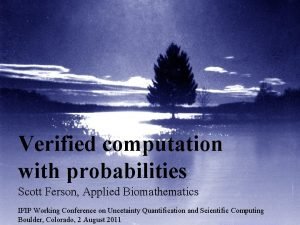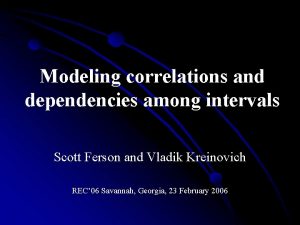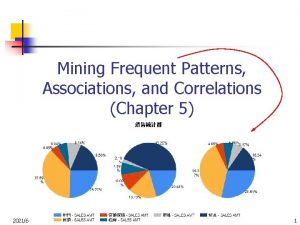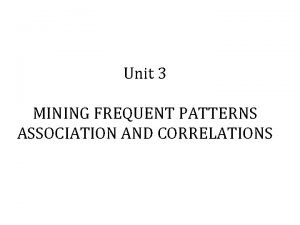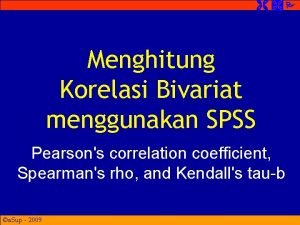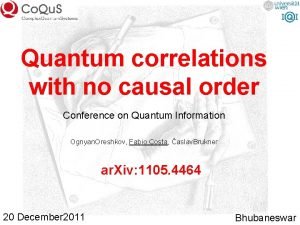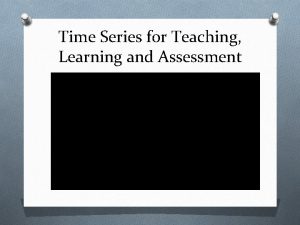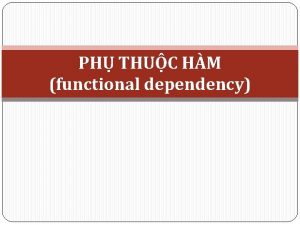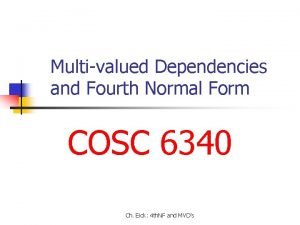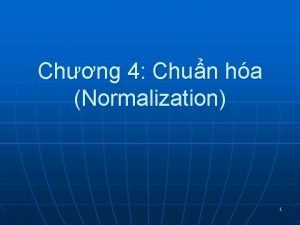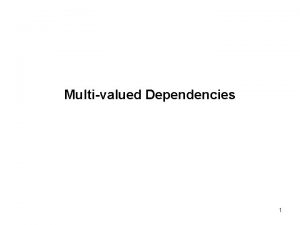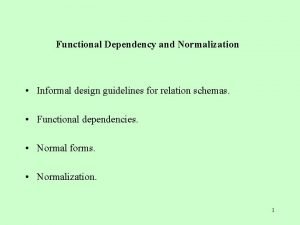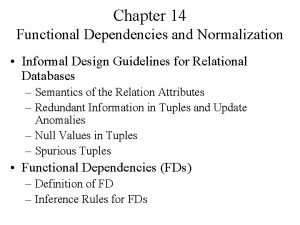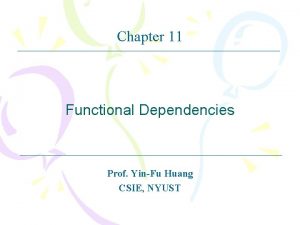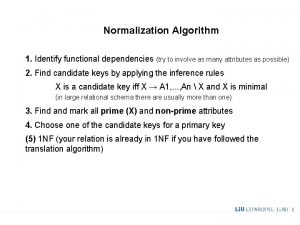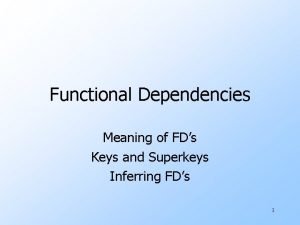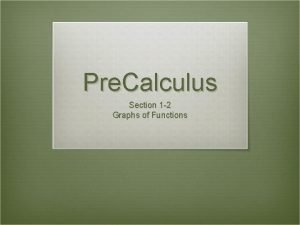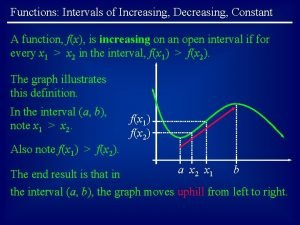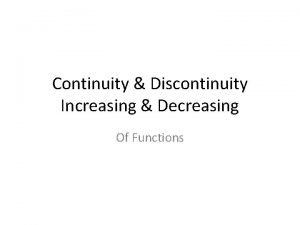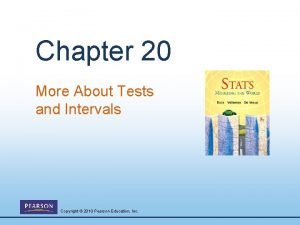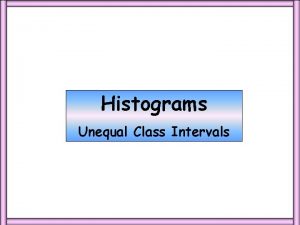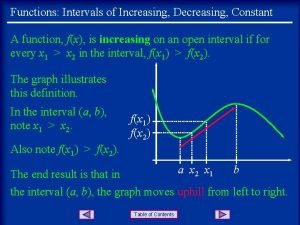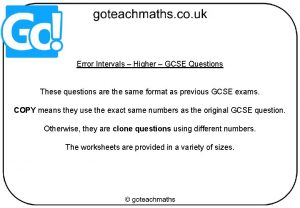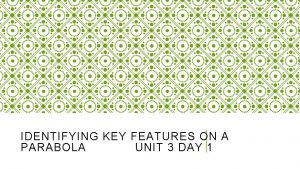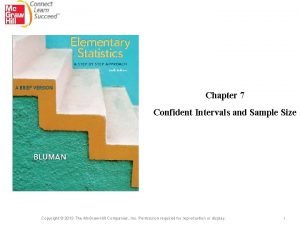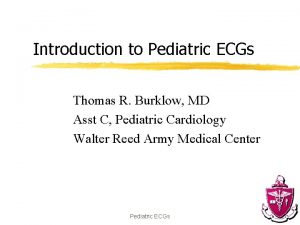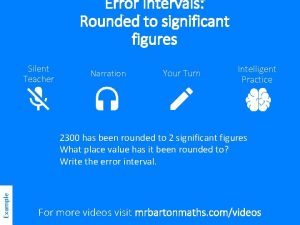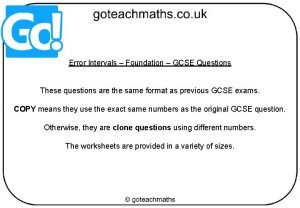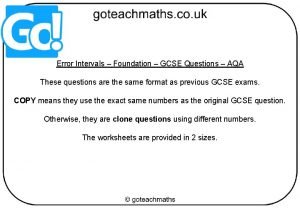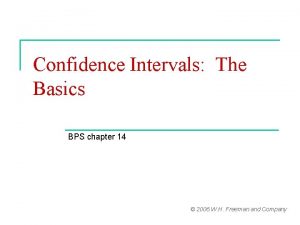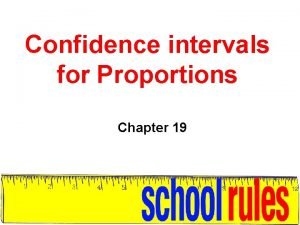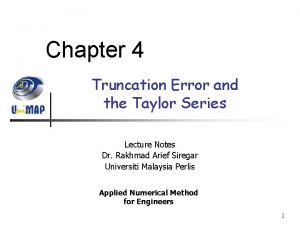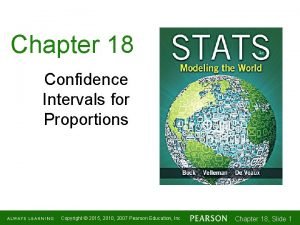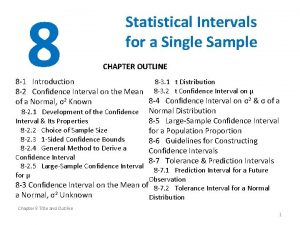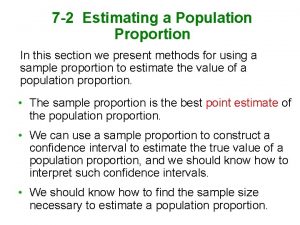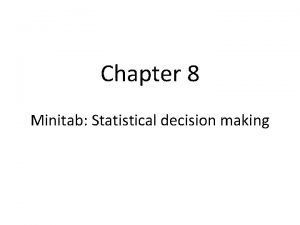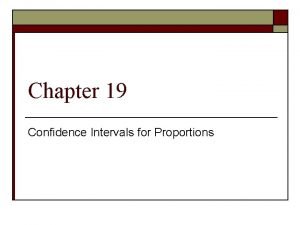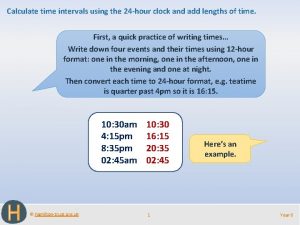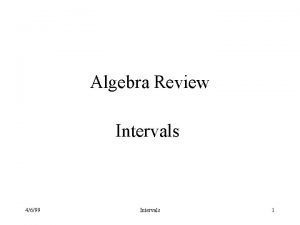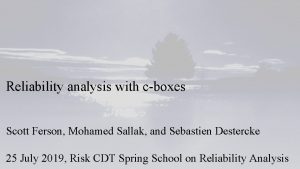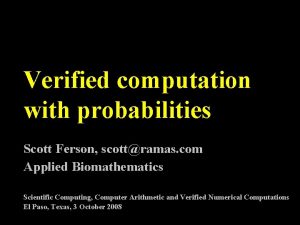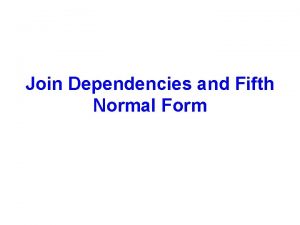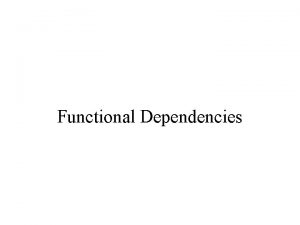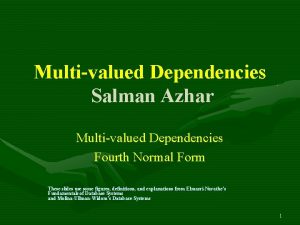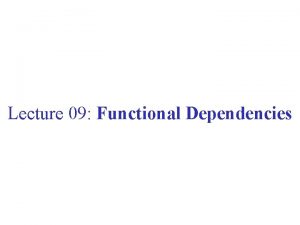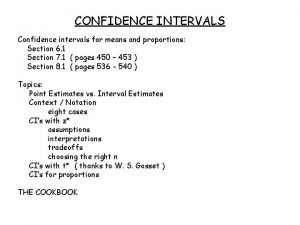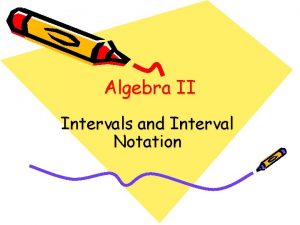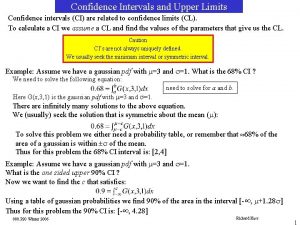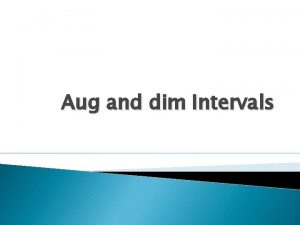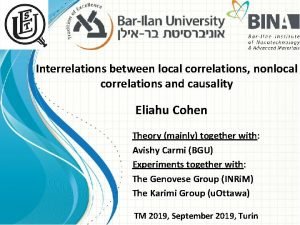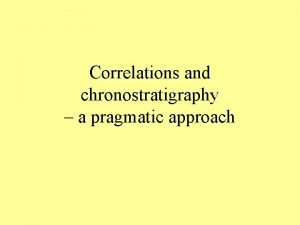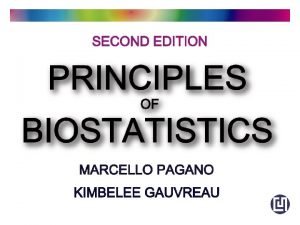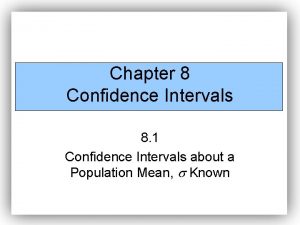Modeling correlations and dependencies among intervals Scott Ferson
















![A+B A = [2, 5] B = [3, 9] [ 5, 14] Perfect [ A+B A = [2, 5] B = [3, 9] [ 5, 14] Perfect [](https://slidetodoc.com/presentation_image_h/8930f70900febba12c5e229cb6ba7ae3/image-17.jpg)







![Cartesian product A+B A [1, 3] p 1 = 1/3 A [2, 4] p Cartesian product A+B A [1, 3] p 1 = 1/3 A [2, 4] p](https://slidetodoc.com/presentation_image_h/8930f70900febba12c5e229cb6ba7ae3/image-25.jpg)

![Opposite/nondependent A+B A [1, 3] p 1 = 1/3 A [2, 4] p 2 Opposite/nondependent A+B A [1, 3] p 1 = 1/3 A [2, 4] p 2](https://slidetodoc.com/presentation_image_h/8930f70900febba12c5e229cb6ba7ae3/image-27.jpg)

![Opposite / opposite A+B A [1, 3] p 1 = 1/3 A [2, 4] Opposite / opposite A+B A [1, 3] p 1 = 1/3 A [2, 4]](https://slidetodoc.com/presentation_image_h/8930f70900febba12c5e229cb6ba7ae3/image-29.jpg)














![Interesting example § X = [ 1, +1], Y ={([ 1, 0], ½), ([0, Interesting example § X = [ 1, +1], Y ={([ 1, 0], ½), ([0,](https://slidetodoc.com/presentation_image_h/8930f70900febba12c5e229cb6ba7ae3/image-44.jpg)
![Compute via Yager’s convolution Y ([ 1, 0], ½) X ([ 1, +1], 1) Compute via Yager’s convolution Y ([ 1, 0], ½) X ([ 1, +1], 1)](https://slidetodoc.com/presentation_image_h/8930f70900febba12c5e229cb6ba7ae3/image-45.jpg)
![But consider the means § § § Clearly, EX = [ 1, +1] and But consider the means § § § Clearly, EX = [ 1, +1] and](https://slidetodoc.com/presentation_image_h/8930f70900febba12c5e229cb6ba7ae3/image-46.jpg)






- Slides: 52

Modeling correlations and dependencies among intervals Scott Ferson and Vladik Kreinovich REC’ 06 Savannah, Georgia, 23 February 2006

Interval analysis Advantages § Natural for scientists and easy to explain § Works wherever uncertainty comes from § Works without specifying intervariable dependencies Disadvantages § Ranges can grow quickly become very wide § Cannot use information about dependence Badmouthing interval analysis?

Probability v. intervals § Probability theory § § Can handle dependence well Has an inadequate model of ignorance LYING: saying more than you really know § Interval analysis § § Can handle epistemic uncertainty (ignorance) well Has an inadequate model of dependence COWARDICE: saying less than you know I said this in Copenhagen, and nobody objected

My perspective § Elementary methods of interval analysis § § Low-dimensional, usually static problems Huge uncertainties Verified computing Important to be best possible § Naïve methods very easy to use § Intervals combined with probability theory § Need to be able to live with probabilists

Dependence in probability theory § 1 Copulas fully capture arbitrary dependence between random variables (functional, shuffles, all) 2 -increasing functions onto [0, 1], with four edges fixed u v 0 M(u, v) = min(u, v) Perfect 1 1 u (u, v) = uv v 0 Independent 1 1 u v 0 1 W(u, v) = max(u+v 1, 0) Opposite

Dependence in the bivariate case § Any restriction on the possible pairings between inputs (any subset of the units square) May also require each value of u to match with at least v, and vice versa § A little simpler than a copula § The null restriction is the full unit square § § Call this “nondependence” rather than independence D denotes the set of all possible dependencies (set of all subsets of the unit square)

Two sides of a single coin § Mechanistic dependence Neumaier: “correlation” § Computational dependence Neumaier: “dependent” Francisco Cháves: decorrelation § § § Same representations used for both Maybe the same origin phenomenologically I’m mostly talking about mechanistic

Three special cases Opposite Nondependent Perfect (countermonotonic) (the Fréchet case) (comonotonic) 1 1 1 v v v 0 0 u 1

Correlation § A model of dependence that’s parameterized by a (scalar) value called the “correlation coefficient” : [ 1, +1] D § The correlation model is called “complete” if ( 1) = , (0) = , (+1) =

Corner-shaving dependence r = 1 r = 0 r = +1 D(r) = { (u, v) : max(0, u r, u 1+r) v min(1, u+1 r, u+2+r)} u [0, 1], v [0, 1] f (A, B) = { c : c = f (u (a 2 – a 1) + a 1, v (b 2 – b 1) + b 1), (u, v) D } A+B = [env(w(A, r)+b 1, a 1+w(B, r)), env(a 2+w(B, 1+r), w(A, 1+r)+b 2)] a 1 if p < 0 w([a 1, a 2], p) = a 2 if 1 < p p(a 2 a 1)+a 1 otherwise

Other complete correlation families r = 1 r = 0 r = +1

Elliptic dependence

Elliptic dependence r = 1 § r = 0 r = +1 Not complete (because r = 0 isn’t nondependence)

Parabolic dependence

Parabolic dependence r = 1 r = 0 r = +1 § A variable and its square or square root have this dependence § Variables that are not related by squaring could also have this dependence relation e. g. , A = [1, 5], B = [1, 10]

So what difference does it make?
![AB A 2 5 B 3 9 5 14 Perfect A+B A = [2, 5] B = [3, 9] [ 5, 14] Perfect [](https://slidetodoc.com/presentation_image_h/8930f70900febba12c5e229cb6ba7ae3/image-17.jpg)
A+B A = [2, 5] B = [3, 9] [ 5, 14] Perfect [ 8, 11] Opposite [ 7. 1, 11. 9] Corner-shaving (r = 0. 7) [ 7. 27, 11. 73] Elliptic (r = 0. 7) [ 5, 14] Upper, left [ 5, 11] Lower, left [ 8, 14] Upper, right [ 5, 14] Lower, right [ 6. 5, 12. 5] Diamond [ 5, 14] Nondependent

Eliciting dependence § As hard as getting intervals (maybe a bit worse) § Theoretical or “physics-based” arguments § Inference from empirical data § Risk of loss of rigor at this step (just as there is when we try to infer intervals from data)

Generalization to multiple dimensions § Pairwise § § § Multivariate § § § Matrix of two-dimensional dependence relations Relatively easy to elicit Subset of the unit hypercube Potentially much better tightening Computationally harder already NP-hard, so doesn’t spoil party

Computing § Sequence of binary operations § § § Need to deduce dependencies of intermediate results with each other and the original inputs Different calculation order may give different results Do all at once in one multivariate calculation § § Can be much more difficult computationally Can produce much better tightening

Living (in sin) with probabilists

Probability box (p-box) Cumulative probability Interval bounds on an cumulative distribution function 1 0 0. 0 1. 0 X 2. 0 3. 0

Generalizes intervals and probability Cumulative probability Probability distribution Probability box Interval 1 1 1 0 0 10 20 30 40 10 20 Not a uniform distribution 30

1 A 0 0 1 2 3 4 5 6 Cumulative Probability bounds arithmetic 1 B 0 0 2 4 6 What’s the sum of A+B? 8 10 12 14
![Cartesian product AB A 1 3 p 1 13 A 2 4 p Cartesian product A+B A [1, 3] p 1 = 1/3 A [2, 4] p](https://slidetodoc.com/presentation_image_h/8930f70900febba12c5e229cb6ba7ae3/image-25.jpg)
Cartesian product A+B A [1, 3] p 1 = 1/3 A [2, 4] p 2 = 1/3 A [3, 5] p 3 = 1/3 B [2, 8] q 1 = 1/3 A+B [3, 11] prob=1/9 A+B [4, 12] prob=1/9 A+B [5, 13] prob=1/9 B [6, 10] q 2 = 1/3 A+B [7, 13] prob=1/9 A+B [8, 14] prob=1/9 A+B [9, 15] prob=1/9 B [8, 12] q 3 = 1/3 A+B [9, 15] prob=1/9 A+B [10, 16] prob=1/9 A+B [11, 17] prob=1/9 independence nondependent

Cumulative probability A+B, independent/nondependent 1. 00 0. 75 0. 50 0. 25 0. 00 0 3 6 9 A+B 12 15 18
![Oppositenondependent AB A 1 3 p 1 13 A 2 4 p 2 Opposite/nondependent A+B A [1, 3] p 1 = 1/3 A [2, 4] p 2](https://slidetodoc.com/presentation_image_h/8930f70900febba12c5e229cb6ba7ae3/image-27.jpg)
Opposite/nondependent A+B A [1, 3] p 1 = 1/3 A [2, 4] p 2 = 1/3 A [3, 5] p 3 = 1/3 B [2, 8] q 1 = 1/3 A+B [3, 11] prob=0 A+B [4, 12] prob=0 A+B [5, 13] prob=1/3 B [6, 10] q 2 = 1/3 A+B [7, 13] prob=0 A+B [8, 14] prob=1/3 A+B [9, 15] prob=0 B [8, 12] q 3 = 1/3 A+B [9, 15] prob= 1/3 A+B [10, 16] prob=0 A+B [11, 17] prob=0 opposite nondependent

A+B, opposite / nondependent Cumulative probability 1 0 0 3 6 9 A+B 12 15 18
![Opposite opposite AB A 1 3 p 1 13 A 2 4 Opposite / opposite A+B A [1, 3] p 1 = 1/3 A [2, 4]](https://slidetodoc.com/presentation_image_h/8930f70900febba12c5e229cb6ba7ae3/image-29.jpg)
Opposite / opposite A+B A [1, 3] p 1 = 1/3 A [2, 4] p 2 = 1/3 A [3, 5] p 3 = 1/3 B [2, 8] q 1 = 1/3 A+B [5, 9] prob=0 A+B [6, 10] prob=0 A+B [7, 11] prob=1/3 B [6, 10] q 2 = 1/3 A+B [9, 11] prob=0 A+B [10, 12] prob=1/3 A+B [11, 13] prob=0 B [8, 12] q 3 = 1/3 A+B [11, 13] prob= 1/3 A+B [12, 14] prob=0 A+B [13, 15] prob=0 opposite

Cumulative probability A+B, opposite / opposite 1. 00 0. 75 0. 50 0. 25 0. 00 0 3 6 9 A+B 12 15 18

Cumulative probability Three answers say different things 1. 00 0. 75 0. 50 0. 25 0. 00 0 3 6 9 A+B 12 15 18

Conclusions § Interval analysis automatically accounts for all possible dependencies § Unlike probability theory, where the default assumption often underestimates uncertainty § Information about dependencies isn’t usually used to tighten results, but it can be § Variable repetition is just a special kind of dependence

End

Success Good engineering Dumb luck Wishful thinking Prudent analysis Honorable failure Negligence Failure

Independence § In the context of precise probabilities, there was a unique notion of independence § In the context of imprecise probabilities, however, this notion disintegrates into several distinct concepts § The different kinds of independence behave differently in computations

Equivalent definitions of independence Several definitions of independence § § § H(x, y) = F(x) G(y) , for all values x and y P(X I, Y J) = P(X I) P(Y J), for any I, J R h(x, y) = f(x) g(y) , for all values x and y E(w(X) z(Y)) = E(w(X)) E(z(Y)), for arbitrary w, z X, Y(t, s) = X(t) Y(s), for arbitrary t and s P(X x) = F(x), P(Y y) = G(y) and P(X x, Y y) = H(x, y); f, g and h are the density analogs of F, G and H; and denotes the Fourier transform For precise probabilities, all these definitions are equivalent, so there’s a single concept

Imprecise probability independence § § § Random-set independence Epistemic irrelevance (asymmetric) Epistemic independence Strong independence Repetition independence Others? Which should be called ‘independence’?

Notation § § § X and Y are random variables FX and FY are their probability distributions FX and FY aren’t known precisely, but we know they’re within classes MX and MY X ~ FX MX Y ~ FY MY

Repetition independence § § X and Y are random variables X and Y are independent (in the traditional sense) X and Y are identically distributed according to F F is unknown, but we know that F M X and Y are repetition independent Analog of iid (independent and identically distributed) MX, Y = {H : H(x, y) = F(x) F(y), F M}

Strong independence § § § X ~ FX MX and Y ~ FY MY X and Y are stochastically independent All possible combinations of distributions from MX and MY are allowed X and Y are strongly independent Complete absence of any relationship between X, Y MX, Y = {H : H(x, y) = FX(x) FY(y), FX MX, FY MY}

Epistemic independence § X ~ FX MX and Y ~ FY MY § E(f(X)|Y) = E(f(X)) and E(f(Y)|X) = E(f(Y)) for all functions f where E is the smallest mean over all possible probability distributions X and Y are epistemically independent Lower bounds on expectations generalize the conditions P(X|Y) = P(X) and P(Y|X) = P(Y)

Random-set independence § Embodied in Cartesian products § X and Y with mass functions m. X and m. Y are random-set independent if the Dempster. Shafer structure for their joint distribution has mass function m(A 1 A 2) = m. X (A 1) m. Y (A 2) whenever A 1 is a focal element of X and A 2 is a focal element of Y, and m(A) = 0 otherwise § Often easiest to compute

These cases of independence are nested. (Uncorrelated) Random-set Epistemic Strong Repetition (Nondependent)
![Interesting example X 1 1 Y 1 0 ½ 0 Interesting example § X = [ 1, +1], Y ={([ 1, 0], ½), ([0,](https://slidetodoc.com/presentation_image_h/8930f70900febba12c5e229cb6ba7ae3/image-44.jpg)
Interesting example § X = [ 1, +1], Y ={([ 1, 0], ½), ([0, 1], ½)} 1 1 X 0 § 1 0 +1 X Y 0 1 0 +1 Y If X and Y are “independent”, what is Z = XY ?
![Compute via Yagers convolution Y 1 0 ½ X 1 1 1 Compute via Yager’s convolution Y ([ 1, 0], ½) X ([ 1, +1], 1)](https://slidetodoc.com/presentation_image_h/8930f70900febba12c5e229cb6ba7ae3/image-45.jpg)
Compute via Yager’s convolution Y ([ 1, 0], ½) X ([ 1, +1], 1) ([ 1, +1], ½) ([0, 1], ½) ([ 1, +1], ½) The Cartesian product with one row and two columns produces this p-box 1 0 XY 1 0 +1 XY
![But consider the means Clearly EX 1 1 and But consider the means § § § Clearly, EX = [ 1, +1] and](https://slidetodoc.com/presentation_image_h/8930f70900febba12c5e229cb6ba7ae3/image-46.jpg)
But consider the means § § § Clearly, EX = [ 1, +1] and EY=[ ½, +½]. Therefore, E(XY) = [ ½, +½]. But if this is the mean of the product, and its range is [ 1, +1], then we know better bounds on the CDF. 1 0 XY 1 0 +1 XY

And consider the quantity signs § § § § What’s the probability PZ that Z < 0? Z < 0 only if X < 0 or Y < 0 (but not both) PZ = PX(1 PY) + PY(1 PX), where PX = P(X < 0), PY = P(Y < 0) But PY is ½ by construction 1 XY So PZ = ½PX + ½(1 PX) = ½ Thus, zero is the median of Z 0 1 0 +1 Knowing median and range improves bounds XY

Best possible § These bounds are realized by solutions If X = 0, then Z=0 If X = Y = B = {( 1, ½), (+1, ½)}, then Z = B 1 1 Z=0 § B 1 0 0 0 So these bounds are also best possible 1 0 +1 XY

So which is correct? Random-set independence 1 1 Moment independence XY 0 1 0 +1 XY Strong independence XY 0 1 0 +1 XY The answer depends on what one meant by “independent”.

So what? § The example illustrates a practical difference between random-set independence and strong independence § It disproves the conjecture that the convolution of uncertain numbers is not affected by dependence assumptions if at least one of them is an interval § It tempers the claim about the best-possible nature of convolutions with probability boxes and Dempster. Shafer structures

Strategy for risk analysts § Random-set independence is conservative § Using the Cartesian product approach is always rigorous, though may not be optimal § Convenient methods to obtain tighter bounds under other kinds of independence await discovery

Uncertainty algebra for convolutions Operands and operation Answers under different dependence assumptions 1) One interval random-set = unknown 2) Two intervals strong = epistemic = random-set = unknown 3) Interval and a function of an interval strong = epistemic = random-set = unknown 4) One interval and monotone operation strong = epistemic = random-set = unknown 5) Monotone operation strong = epistemic = random-set 6) Two precise distributions strong = epistemic = random-set 7) All cases repetition strong epistemic random-set unknown (after Fetz and Oberguggenberger 2004) (Colored words denote the set of distributions that result from binary operations invoking the specified assumption about dependence)
 Scott ferson
Scott ferson Scott ferson
Scott ferson El mac ferson
El mac ferson Associations and correlations in data mining
Associations and correlations in data mining Associations and correlations in data mining
Associations and correlations in data mining Mining frequent patterns associations and correlations
Mining frequent patterns associations and correlations Erickson nursing theory
Erickson nursing theory Korelasi 6 pair
Korelasi 6 pair Quantum correlations with no causal order
Quantum correlations with no causal order Spurious correlations
Spurious correlations Illusory correlations ______.
Illusory correlations ______. Dimensional modeling vs relational modeling
Dimensional modeling vs relational modeling Volere template
Volere template Assumptions and dependencies example
Assumptions and dependencies example Functional dependencies and normalization
Functional dependencies and normalization Multi-valued dependency
Multi-valued dependency Functional dependencies and normalization
Functional dependencies and normalization Multivalued dependency
Multivalued dependency Informal design guidelines for relational schemas
Informal design guidelines for relational schemas Dependencies adrenalin ui
Dependencies adrenalin ui Functional dependencies شرح بالعربي
Functional dependencies شرح بالعربي Closure of a set
Closure of a set Identify functional dependencies
Identify functional dependencies Fd's meaning
Fd's meaning Reuse/release equivalence principle
Reuse/release equivalence principle How to find increasing and decreasing intervals on a graph
How to find increasing and decreasing intervals on a graph Increasing decreasing and constant
Increasing decreasing and constant Increasing intervals
Increasing intervals Chapter 20 more about tests and intervals
Chapter 20 more about tests and intervals Histogram for unequal class intervals
Histogram for unequal class intervals Increasing decreasing constant
Increasing decreasing constant Error intervals gcse questions
Error intervals gcse questions Interval of increase and decrease parabola
Interval of increase and decrease parabola Confident
Confident Importance of confidence interval
Importance of confidence interval Mild left axis deviation
Mild left axis deviation How to do error intervals
How to do error intervals Error interval questions
Error interval questions What is an error interval
What is an error interval Ecg small square time
Ecg small square time Critical value for z score
Critical value for z score Reporting confidence intervals
Reporting confidence intervals Sample size confidence level
Sample size confidence level Critical value for 90 confidence interval
Critical value for 90 confidence interval Confidence interval excel
Confidence interval excel Truncation error taylor series
Truncation error taylor series Chapter 18 confidence intervals for proportions
Chapter 18 confidence intervals for proportions Statistical intervals for a single sample
Statistical intervals for a single sample How to interpret confidence intervals example
How to interpret confidence intervals example 95 confidence interval ti 84
95 confidence interval ti 84 Confidence intervals minitab
Confidence intervals minitab Chapter 19 confidence intervals for proportions
Chapter 19 confidence intervals for proportions How to write time in 24 hour clock
How to write time in 24 hour clock
